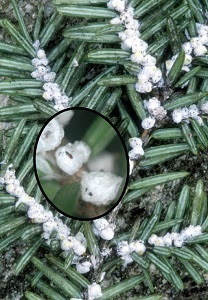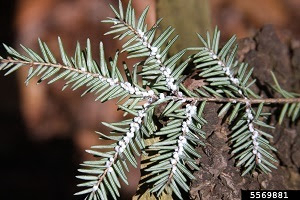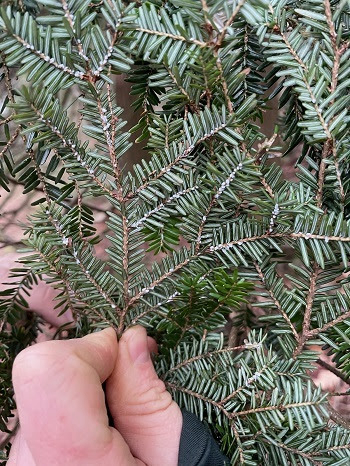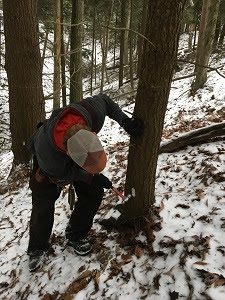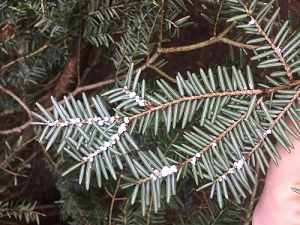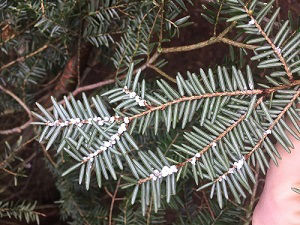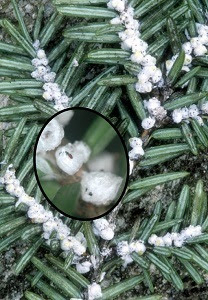MIchigan: Invasive Hemlock Woolly Adelgid Found in Mason County
Contact: James Wieferich (DNR), 517-242-6300
Invasive hemlock woolly adelgid found in Mason County
The Michigan Department of Natural Resources today confirmed the presence of hemlock woolly adelgid in southern Mason County. Prior to this detection, known infestations were limited to Allegan, Ottawa, Muskegon and Oceana counties.
 The Mason County site near Bass Lake is 4.5 miles north of Charles Mears State Park in Oceana County, previously considered the northern limit of infestation in Michigan. The Mason County site near Bass Lake is 4.5 miles north of Charles Mears State Park in Oceana County, previously considered the northern limit of infestation in Michigan.
Hemlock woolly adelgids are small insects that use their long, siphoning mouthparts to extract sap from hemlock trees. Their feeding weakens needles, shoots and branches. Over time, tree growth slows and trees take on a grayish-green appearance. Without treatment, infested trees die within four to 10 years. The DNR’s forest health field crew detected the Mason County infestation while conducting a hemlock woolly adelgid survey on municipal land Feb. 20, and the United States Department of Agriculture’s Animal and Plant Health Inspection Service – Plant Protection and Quarantine program later verified it. |
Response efforts
 Over the next few weeks, the DNR and partner agencies will be contacting public and private landowners near the detection in Mason County and requesting permission to survey trees for hemlock woolly adelgid. Surveys are free, and landowners are encouraged to participate to help determine the extent of the infestation. Over the next few weeks, the DNR and partner agencies will be contacting public and private landowners near the detection in Mason County and requesting permission to survey trees for hemlock woolly adelgid. Surveys are free, and landowners are encouraged to participate to help determine the extent of the infestation.
This spring, crews will focus on treating infested trees to prevent hemlock woolly adelgid from spreading further northward. The Michigan Department of Agriculture and Rural Development anticipates expanding the hemlock woolly adelgid internal quarantine, currently in place for Allegan, Ottawa, Muskegon and Oceana counties, to include Mason County. The quarantine restricts the movement of hemlock nursery stock and unprocessed hemlock products from or within quarantined counties without an MDARD compliance agreement and appropriate certification. |
Ongoing management
 In addition to the hemlock woolly adelgid internal quarantine, issued in 2017, MDARD has maintained an external quarantine regulating out-of-state shipments of hemlock since 2001. In addition to the hemlock woolly adelgid internal quarantine, issued in 2017, MDARD has maintained an external quarantine regulating out-of-state shipments of hemlock since 2001.
Since 2017, Michigan’s Hemlock Woolly Adelgid Coordinating Committee, which includes representatives from DNR, MDARD, Michigan State University and the USDA Forest Service, has directed survey efforts in counties bordering Lake Michigan. To date, crews from the DNR and West Michigan Cooperative Invasive Species Management area have treated over 40,000 hemlocks on public and private lands. |
Help by checking your trees
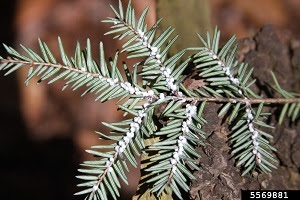 Late fall through early spring is the best time to check hemlock trees for the presence of hemlock woolly adelgid. Look on the undersides of branches for evidence of round, white ovisacs near the base of the needles. Late fall through early spring is the best time to check hemlock trees for the presence of hemlock woolly adelgid. Look on the undersides of branches for evidence of round, white ovisacs near the base of the needles.
Up close, ovisacs look like balls of spun cotton and may appear alone or in clusters. The short video Hemlock woolly adelgid: invasive species in Michiganprovides helpful identification tips. |
Report your findings
Report infested hemlock by using the Midwest Invasive Species Information Network, available online at MISIN.MSU.edu or as a downloadable smartphone app. The MISIN smartphone app will take a GPS location point if a report is made at the site; it also will allow you to upload photos with a report.
Reports can be made by email to MDA-Info@Michigan.gov or by phone to the MDARD Customer Service Center at 800-292-3939.
Identify the location of infested trees and, whenever possible, take one or two pictures of infested branches to help confirm identification. To avoid spreading the insect, do not collect sample branches or twigs.
Michigan’s Invasive Species Program is cooperatively implemented by the Michigan departments of Agriculture & Rural Development; Environment, Great Lakes, and Energy; and Natural Resources.

